
The tribe Euglossini, in the subfamily Apinae, commonly known as orchid bees or euglossine bees, are the only group of corbiculate bees whose non-parasitic members do not all possess eusocial behavior.

The term cuckoo bee is used for a variety of different bee lineages which have evolved the kleptoparasitic behaviour of laying their eggs in the nests of other bees, reminiscent of the behavior of cuckoo birds. The name is perhaps best applied to the apid subfamily Nomadinae, but is sometimes used in Europe to mean bumblebees (Bombus) in the subgenus Psithyrus. Females of cuckoo bees are easy to recognize in almost all cases, as they lack pollen-collecting structures and do not construct their own nests. They often have reduced body hair, abnormally thick and/or heavily sculptured exoskeleton, and saber-like mandibles, although this is not universally true; other less visible changes are also common.
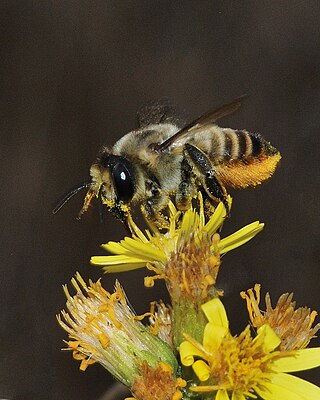
The genus Megachile is a cosmopolitan group of solitary bees, often called leafcutter bees or leafcutting bees; it also includes the called resin bees and mortar bees. While other genera within the family Megachilidae may chew leaves or petals into fragments to build their nests, certain species within Megachile neatly cut pieces of leaves or petals, hence their common name. This is one of the largest genera of bees, with more than 1500 species in over 50 subgenera. The alfalfa leafcutter bee is managed on a commercial scale for crop pollination, and has been introduced by humans to various regions around the world.
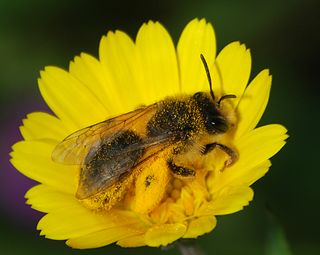
Andrena is a genus of bees in the family Andrenidae. With over 1,500 species, it is one of the largest genera of animals. It is a strongly monophyletic group that is difficult to split into more manageable divisions; currently, Andrena is organized into 104 subgenera. It is nearly worldwide in distribution, with the notable exceptions of Oceania and South America. Bees in this genus are commonly known as mining bees due to their ground-nesting lifestyle.
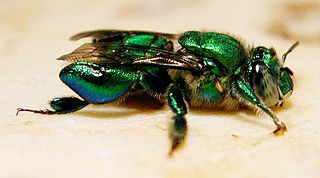
Euglossa is a genus of orchid bees (Euglossini). Like all their close relatives, they are native to the Neotropics; an introduced population exists in Florida. They are typically bright metallic blue, green, coppery, or golden.
Pappognatha is a genus of mutillid wasps. Some members of this genus are ant mimics. These wasps occur in Central and South America, and are parasites in the arboreal nests of orchid bees in the genus Euglossa.
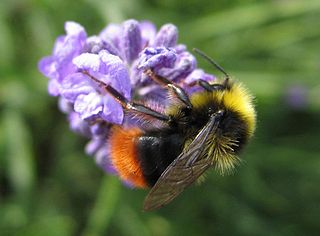
Pyrobombus is a subgenus of bumblebees, with its centres of diversity in Central Asia and north-western North America. Nearly a fifth of all Bombus species fall within Pyrobombus and its member species vary considerably in size, appearance and behaviour. it covers 43 species of bees and is the largest subgenus of bumblebees, covering almost 50% of the North American fauna. They are seen to be declined by 6%, which may be an undervalued statistic, although not as high as other groups of bees. Pyrobombus bees also face issues such as climate change, loss of habitat, urbanization, and industrial agriculture. This subgenus of bees can pollinate which helps plants fertilise and grow fruit that is essential to the biodiversity and life of the environment. Commonly, Pyrobombus bees are used for beekeeping as they are pollinators. They can be for wax, honey, venom, combs, and such which may be collected for commercial use. This subgenus may vary in their characteristics such as body size, wingspan, and tongue length for individual species, but like all bees, they possess wings, a head, thorax, and abdomen.
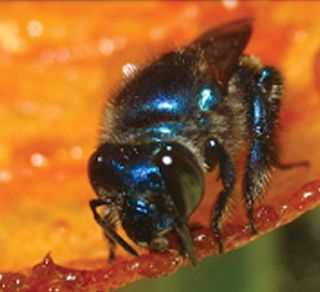
Euglossa hyacinthina, is a species of the orchid bee tribe Euglossini in the family Apidae. With a tongue that can get up to as long as 4 cm, this orchid bee species is found in Central America. Living in a neotropical climate, E.hyacinthina has adapted to hot and humid weather. The bee has darkly shaded, translucent wings and a metallic, glossy blue skeleton.
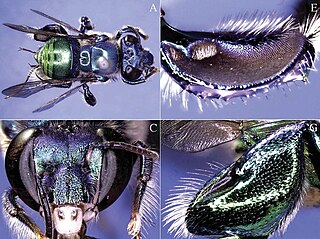
Euglossa bazinga is a euglossine bee species found in Brazil. It is named after the catchphrase of the fictional character Dr. Sheldon Cooper from the television show The Big Bang Theory. It was previously misidentified as Euglossa ignita, and is threatened with habitat loss.
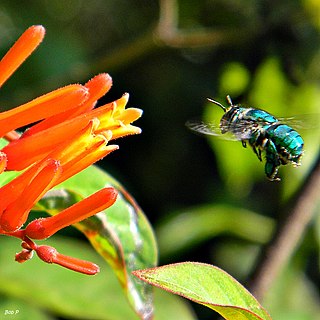
Euglossa dilemma, the green orchid bee or dilemma orchid bee, is a species of solitary euglossine bee native to a broad area of Central America, and recently introduced to Florida in the United States. It was first detected in Broward County, Florida in 2003, and initially identified as Euglossa viridissima, but further study revealed that E. viridissima as previously defined consisted of two cryptic species, and the one present in Florida was new to science.
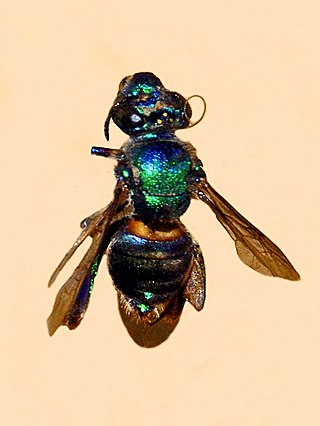
Euglossa cordata is a primitively eusocial orchid bee of the American tropics. The species is known for its green body color and ability to fly distances of over 50 km. Males mostly disperse and leave their home nests, while females have been observed to possess philopatric behavior. Because of this, sightings are rare and little is known about the species. However, it has been observed that adults who pollinate certain species of orchids will become intoxicated during the pollination.
Euglossa jacquelynae is a Euglossine bee species found in Central Brazil.
Euglossa solangeae is a Euglossine bee species found in coastal southeastern Brazil. It is believed to be part of the Euglossa stellfeldi group.
Euglossa sovietica is a Euglossine bee species found in the western Brazilian Amazon. It is believed to be part of the Euglossa purpurea group.

Euglossa imperialis is a bee species in the family Apidae. It is considered to be one of the most important pollinators to many Neotropical orchid species in mainland tropical America. It is also one of the most common non-parasitic euglossine species in lowland Panama. E. imperialis, unlike many other bee species, is not a social bee in the sense that there is no apparent morphological or physiological division within the species to distinguish individual bees to be part of a worker or reproductive caste.

Euglossopteryx is an extinct genus of bee in the family Apidae known from a fossil found in North America. There is one described species in the genus, Euglossopteryx biesmeijeri.

Euglossa villosa is a species of orchid bee in the genus Euglossa. It has been found in Mexico, Guatemala, Nicaragua, Costa Rica, and Panama.

Euglossa mixta is a species of orchid bee native to Central America and South America, it is a member of the genus Euglossa a group of brilliant green and blue bees specialized in pollinating certain species of orchids.

Vanilla odorata, also known as vanilla tlatepusco, is a species of flowering plant in the family Orchidaceae, native to southern Mexico, Central America, and tropical South America. With Vanilla planifolia it is a parent of the vanilla crop species Vanilla × tahitensis.

Euglossa viridissima is a species of orchid bee native to Central America, historically confused with a cryptic sister species, Euglossa dilemma.
















